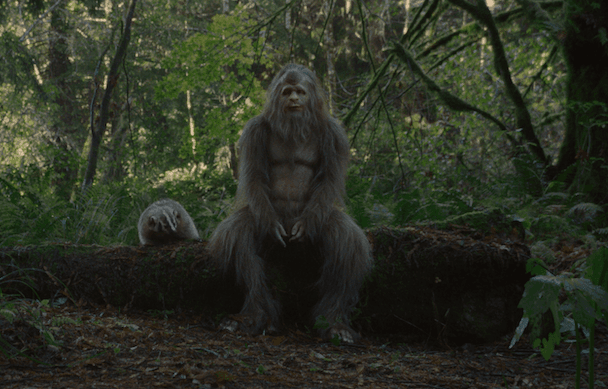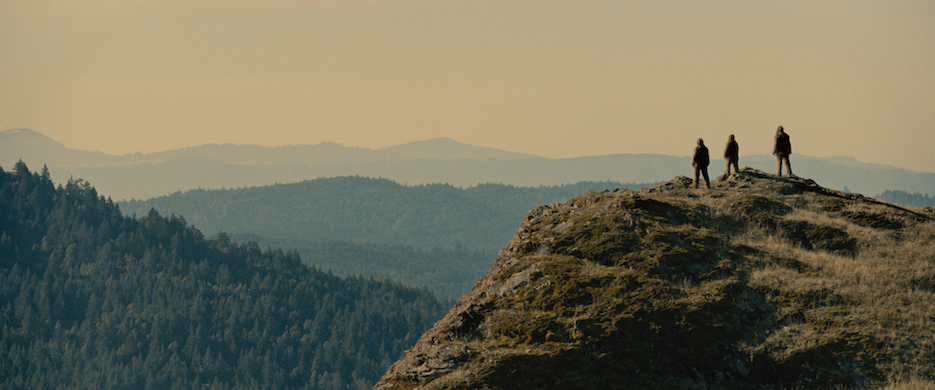Imagine the Ever Loquacious Jesse Eisenberg Grunting Through His Latest, ‘Sasquatch Sunset’
Imagining seeing the film may be enough. If only everyone involved had played up to the level set by the director of photography, Michael Gioulakis, who captures the splendor of the California woods like nobody’s business.

Not a few minutes into Jesse Eisenberg’s post-screening Q&A for his latest film, “Sasquatch Sunset,” I attempted to reformulate the old saw about how children should be seen and not heard. Might the same be said for movie stars? The loquacious Mr. Eisenberg — buzzing, I think, on too many cups of coffee — spoke at length about the picture’s technical issues, predominantly the challenges of acting while wearing prosthetics. An artist talking about his craft: interesting.
Yet Mr. Eisenberg then started waxing philosophic on commodification, clearcutting, and the devastating effects both have had on the health and wellbeing of Bigfoot — that is to say, an invented creature. Mr. Eisenberg was, one supposes, speaking to the trepidations he has about his own species and, in the end, correctly pointed out how any political commentary the film might contain was underplayed for the sake of comedy. Still, the actor’s peregrinations were self-validating enough to make one wish he had stuck to the script.
The script of “Sasquatch Sunset” — a picture absent of words — includes plenty of grunts, along with yelps, growls, and other guttural declamations. The only words we do hear come from the song “Love to Hate You” by a 1980s synth-pop duo, Erasure. When two of our characters — the lone female Bigfoot (Riley Keough) and a young male (Christophe Zajac-Denek) — come across a campsite, their explorations inadvertently result in the pushing of a cassette radio’s “play” button. Music ensues and our hairy pair stand entranced. It’s one of the best scenes in the picture.
This shared reverie can’t last forever, and the two sasquatches subsequently destroy what remains of the campsite, allowing a nearby raccoon to feast on the unspooling cassette tape. Given the vintage technology and distinct lack of human beings — there is evidence of their doings, but no actual people — we’re left to wonder when, exactly, these events take place. The landscape through which our Bigfoots travel is simultaneously Edenic and post-apocalyptic. Ambiguity suits the purposes of the filmmakers.

“Sasquatch Sunset” was written by David Zellner, who co-directed with his brother Nathan. The pair are likely best known for “Kumiko, the Treasure Hunter” (2014), a quixotic film based on the tale of a young Japanese woman who died in search of a fictional ransom hidden by the character portrayed by Steve Buscemi in the film “Fargo” (1996). There’s a haze of legend surrounding that based-on-a-true-story picture, just as there is for the Zellner brothers’ current movie.
The Zellner brothers have long been fascinated by the grainy Patterson-Gimlin film of a hairy creature sauntering through the woods of northern California — come on, we’ve all seen it — and made a short film based on it a good decade ago, “Sasquatch Birth Journal No. 2” (2011). That picture, which is hardly more than a scene, is pretty much recreated during the run of “Sasquatch Sunset,” albeit with better and grislier special effects. David Zellner points to rumors heard of similar creatures throughout the world. “So what is it about human nature,” he asks, “that we need Bigfoot?”
“Sasquatch Sunset” doesn’t answer the question, preferring to let a group of four nameless creatures — the other two are adult males (Nathan Zellner and Mr. Eisenberg) — wander through the woods searching for food, counting the stars, encountering wildlife, and letting loose, so to speak, with their bodily functions. Tragedy strikes in a way that will have those who remember a Paul Newman vehicle, “Sometimes A Great Notion” (1971), chuntering in acknowledgement.
Notwithstanding the evident research that was done for the story — consulting with an anthropologist and all — the Zellners’ film isn’t quite as sui generis as it wants to be. Burdened by a strain of humor that is alternately puerile and oh-so-affected, “Sasquatch Sunset” is fairly conventional in its parameters. Here we have a gross-out comedy for Gen Zers who have gone to college.
Would that everyone had played up to the level set by the director of photography, Michael Gioulakis, who captures the splendor of the California woods like nobody’s business. Otherwise, this bigfooted novelty is best left to audiences with a taste for star-powered indulgences.

